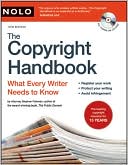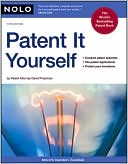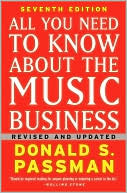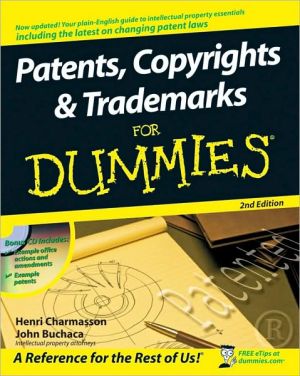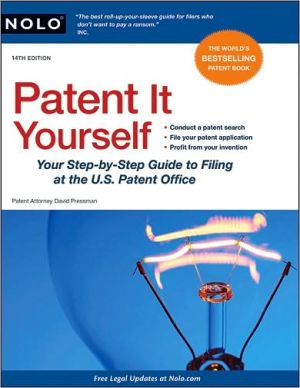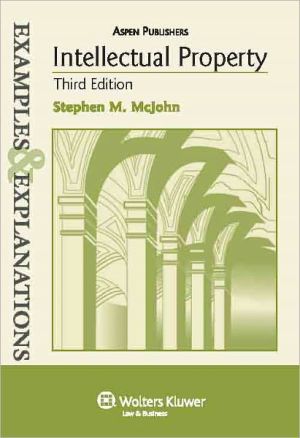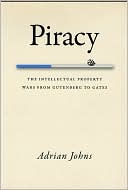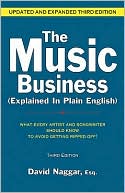The Copyright Handbook: What Every Writer Needs to Know
Search in google:
Ignorance is not bliss in the information age. If you create original works, you must understand copyright law or risk becoming a skid mark on the information superhighway. The Copyright Handbook provides you with all the information and forms you'll need to protect all types of creative expression under U.S. and international copyright law. Written in plain English, this must-have handbook tells you everything you need to know about: *how to register a written work with the copyright office*what works can be protected*when and how to use a copyright notice*copyright protection for works for hire, adaptations, new editions, electronic mail, literary works and periodicals, and compilations (databases and catalogs)*rights and duration of ownership*transfer of copyright ownership*what constitutes infringement and how to avoid it*how to recognize an adapted or recast work*fair use: when and how copyrighted material can be used*electronic publishing rights*registration of multimedia works and multimedia rights*how to protect written works on the Internet The 8th edition of The Copyright Handbook is completely updated to provide the latest case law, copyright registration forms and copyright regulations. It also provides a new section on permissions and releases. All forms are included as tear-outs and on CD-ROM. Small Business Opportunities Don't do anything without reading Consultant & Independent Contractor Agreements.... [This] book will help you understand the importance of written agreements and will show you exactly how to put your agreement together.
1. How to Use This Book How This Book Is Organized Which Parts of This Book You Should Read What This Book Is Not About Icons Used Throughout the Book 2. Copyright Basics Why Have a Copyright Law? What Is Copyright? How Is a Copyright Created and Protected? What Copyright Protects Limitations on Copyright Protection Copyright Ownership and Transfer of Ownership How Long a Copyright Lasts Copyright Infringement Other Protections for Intellectual Property 3. Copyright Notice Introduction When Copyright Notice Is Required Why Provide a Copyright Notice on Published Works? When to Provide Notice Form of Notice Notice on Compilations and Adaptations Book Dust Jackets Multimedia Works Where to Place Copyright Notice Other Information Near Notice Copyright Notice on Unpublished Manuscripts 4. Copyright Registration What Is Copyright Registration? Why Register? What Can and Should Be Registered Who Can Register? Registration as a Single Unit Registering Derivative Works and Compilations Four-Step Registration Process Selecting the Appropriate Registration Form How to Complete Form TX How to Complete Form PA Registering Newspapers, Magazines, Newsletters, and Other Periodicals: Form SE, Short Form SE, Form SE/Group, Form G/DN Registering a Group of Contributions to Periodicals: Form GR/CP Satisfying Copyright Office Deposit Requirements Sending Your Application to the Copyright Office Expedited Registration Preregistration of Unpublished Works Dealing With the Copyright Office Full-Term Retention of Deposits and Other Ways to Preserve Deposits Correcting Errors After Registration Is Completed 5. Correcting or Changing Copyright Notice or Registration Part I: Dealing With Errors or Omissions in Copyright Notice Works Published After March 1, 1989 Copies Published Between January 1, 1978 and February 28, 1989 Works Published Before 1978 Types of Errors or Omissions That Invalidate a Copyright Notice Part II: Dealing With Errors or Changes Affecting Copyright Registration: Supplemental Registration Why a Supplemental Registration Should Be Filed (When Appropriate) When Supplemental Registration Is Not Appropriate Supplemental Registration Procedure Effect of Supplemental Registration 6. What Copyright Protects What Copyright Protects: Tangible, Original Expression What Copyright Does Not Protect: The Boundaries of the Public Domain Distinguishing Between Protected Expression and Material in the Public Domain: Putting It All Together 7. Adaptations and Compilations Derivative Works Compilations 8. Initial Copyright Ownership Independent Authorship by an Individual Works Made for Hire Jointly Authored Works 9. Transferring Copyright Ownership How Copyright Ownership Rights Are Transferred to Others Rights Retained by Author After Transfer Copyright Transfers Between Freelance Writers and Magazines and Other Periodicals Copyright Transfers Between Writers and Book Publishers Transfer Documents Marriage, Divorce, and Copyright Ownership Recording Copyright Transfers With the Copyright Office 10. Copyright Duration Works Created During or After 1978 End of Calendar Year Rule Works Created but Not Published or Registered Before January 1, 1978 Works Published or Registered Before January 1, 1978 Special Rules for Works First Published Abroad Before 1978 Duration of Copyright in Adaptations (Derivative Works) Termination of Transfers of Renewal Term Rights in -Pre-?1978 Works 11. Using Other Authors' Words Introduction Introduction to the Fair Use Privilege When Is a Use a Fair Use? Fair Use and the Photocopy Machine Copying by Libraries and Archives Other Fair Uses 12. Copyright Infringement: What It Is, What to Do About It, How to Avoid It What Is Copyright Infringement? How to Know Whether You Have a Valid Infringement Claim When Copying Protected Expression Is Excused Self-Help Remedies for Copyright Infringement Overview of Copyright Infringement Lawsuits What You Can Get If You Win: Remedies for Copyright Infringement What to Do If You're Accused of Infringement 13. International Copyright Protection International Protection for U. S. Citizens and Nationals Protection in the U. S. for Non?U. S. Citizens Copyright Protection in Canada Marketing Your Work in Foreign Countries 14. Copyright in the Online World, Electronic Publishing, and Multimedia What's Available Online What Online Materials Qualify for Copyright Rights Enjoyed by Copyright Owners Online How Copyright Protects Different Types of Online Works Copyright Infringement Online Copyright Formalities: Notice and Registration Electronic Publishing and Ownership of Electronic Rights Multimedia Works Electronic Databases 15. Copyright and Taxation Writers' Income Tax Deductions Taxation of Copyright Income 16. Obtaining Copyright Permissions Who Owns the Text? Start With Online Permission Services Locate the Publisher Contact the Author Special Situations When You Can't Find the Rights Holder Negotiating Text Permission and Fees 17. Help Beyond This Book Intensive Background Resources Primary Source Materials on Copyright Finding a Copyright Lawyer Appendix A. Sample Forms 1. Single unpublished work (a novel); single author 2. Single published work; single author; photos registered separately by photographer 3. Single published work; five joint authors; publisher acquired all copyrights 4. Single work made for hire; previously published under another title and revised; a derivative work 5. Published book; derivative work based on previously published article; joint authors: one the author of the text, the other the photographer; text and photos registered together as a single unit of publication 6. Single published work; publisher acquired all rights in text; text and work for hire cover art and copy registered together as a single unit of publication 7. Published compilation (anthology); publisher registers for the authors 8. Single author; contribution to collective work 9. Group of contributions to periodicals in a 12-month period; a single author 10. Original screenplay by a single author 11. Unpublished song lyric; single author 12. Three monthly issues of a monthly magazine registered as a group on Form SE/Group 13. Single magazine issue 14. Single issue of a magazine published three times a year; single author; not a work made for hire Appendix B. How to Use the CD-ROM A. Installing the Form Files Onto Your Computer B. Using the Word Processing Files to Create Documents C. Using United States Copyright Office Forms Index
